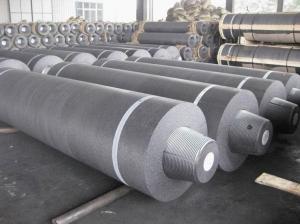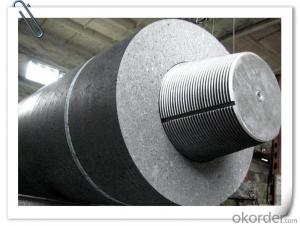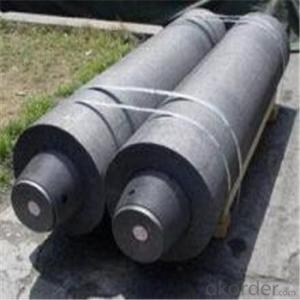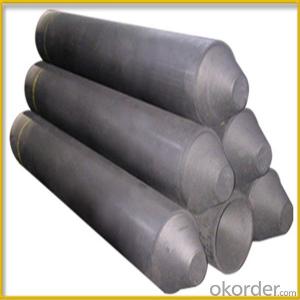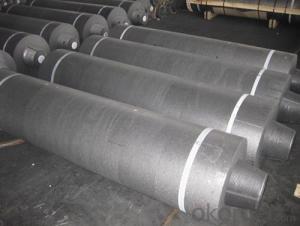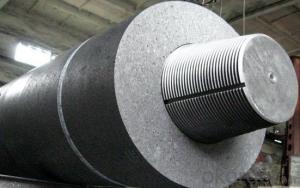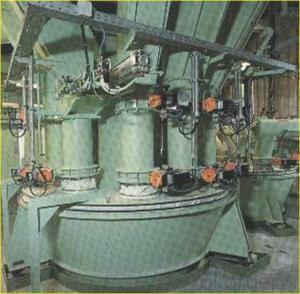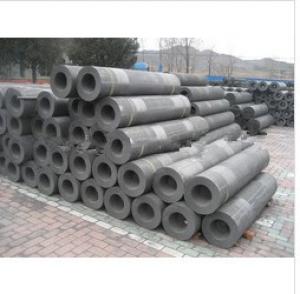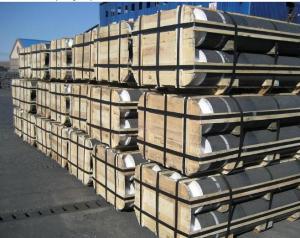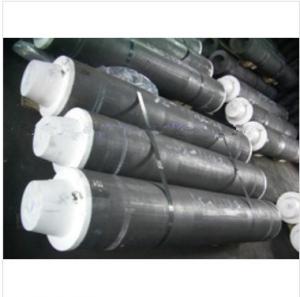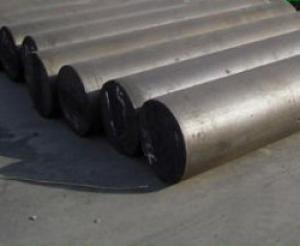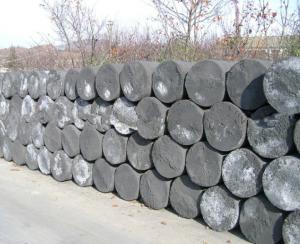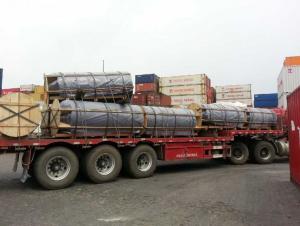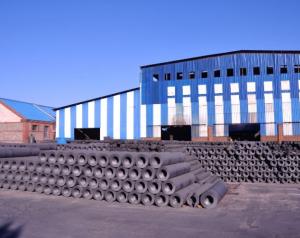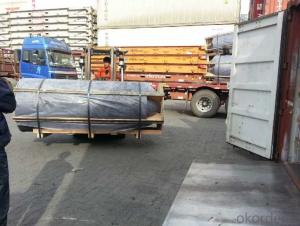Graphite Electrode with Technical Properties from CNBM
- Loading Port:
- Shanghai
- Payment Terms:
- TT or LC
- Min Order Qty:
- 10 m.t.
- Supply Capability:
- 100000 m.t./month
OKorder Service Pledge
OKorder Financial Service
You Might Also Like
TECHNICAL PROPERTIES OF GRAPHITE ELECTRODE
1.Physical and chemical index
Item | Unit | RP | HP | UHP | ||||
250-400 | 450-800 | 300-400 | 450-700 | 300-400 | 450-700 | |||
Electric Resistivity | Electrode | μΩ.m | 7.5-8.6 | 7.5-8.8 | 5.5-6.8 | 5.5-7.0 | 4.6-6.0 | 4.8-6.2 |
Nipple | 4.5-5.5 | 4.0-5.0 | 3.5-4.5 | |||||
Bending Strength | Electrode | MPa | ≥8.0 | ≥11.0 | ≥11.0 | |||
Nipple | ≥15.0 | ≥16.0 | ≥18.0 | |||||
Elastic Modulus | Electrode | GPa | ≤9.0 | ≤11.0 | ≤13.0 | |||
Nipple | ≤13.0 | ≤14.0 | ≤15.0 | |||||
Bulk Density | Electrode | g/cm3 | 1.55-1.65 | 1.63-1.73 | 1.65-1.75 | |||
Nipple | 1.70-1.75 | 1.73-1.80 | 1.75-1.82 | |||||
Ash | Electrode | % | ≤0.3 | |||||
Nipple | ||||||||
CTE (100-600)℃ | Electrode | 10-6/℃ | 2.00-2.50 | 1.80-2.00 | 1.30-1.50 | |||
Nipple | 1.50-1.80 | 1.50-1.80 | 1.20-1.40 | |||||
2.Recommended current carrying capacity
Nominal Diameter (mm) | RP | HP | UHP | ||||
Current Carrying Capacity | Current Density | Current Carrying Capacity | Current Density | Current Carrying Capacity | Current Density | ||
in | mm | A | A/cm2 | A | A/cm2 | A | A/cm2 |
12 | 300 | 1000-13000 | 14-18 | 13000-174000 | 17-24 | 15000-22000 | 20-30 |
14 | 350 | 13500-18000 | 14-18 | 17400-24000 | 17-24 | 20000-30000 | 20-30 |
16 | 400 | 18000-23500 | 14-18 | 21000-31000 | 16-24 | 25000-40000 | 19-30 |
18 | 450 | 22000-27000 | 13-17 | 25000-40000 | 15-24 | 32000-45000 | 19-27 |
20 | 500 | 25000-32000 | 13-16 | 30000-48000 | 15-24 | 38000-55000 | 18-27 |
22 | 550 | 32000-40000 | 13-16 | 35000-55000 | 14-22 | 42000-64000 | 17-26 |
24 | 600 | 35000-41000 | 13-15 | 41000-61000 | 14-21 | 50000-73000 | 17-25 |
28 | 700 | 39000-48000 | 10-12 | 55000-82000 | 14-21 | 67000-99000 | 17-25 |
32 | 800 | 43000-54000 | 8-10 | / | / | / | / |
TOLERANCCES OF ELECTRODE DIAMETERS AND LENG THES (MM)
Nominal Diameter | Actual Diameter | Length | |||
in | mm | max | min | Black surface min | |
12 | 300 | 307 | 302 | 299 | 1800/2000 |
14 | 350 | 357 | 352 | 349 | 1800/2000/2200 |
16 | 400 | 409 | 403 | 400 | 1800/2000/2200 |
18 | 450 | 460 | 454 | 451 | 1800/2000/2200 |
20 | 500 | 511 | 505 | 502 | 2000/2200/2400 |
22 | 550 | 562 | 556 | 553 | 2000/2200/2400 |
24 | 600 | 613 | 607 | 604 | 2200/2400/2700 |
28 | 700 | 714 | 708 | 705 | 2400/2700 |
29 | 800 | 815 | 809 | 806 | 2700/3000 |
SIZE OF TAPER-THREAD NIPPLES AND SOCKETS(MM)
Nominal Length | Standard Deviation | Deviation of the short scale length | ||
1800 | +100 | -100 | -100 | -275 |
2000 | +100 | -100 | -100 | -275 |
2200 | +100 | -100 | -100 | -275 |
2400 | +100 | -100 | -100 | -275 |
2700 | +150 | -150 | -150 | -300 |
3000 | +150 | -150 | -150 | -300 |
FINE-GRAIN SPECIALTY GRAPHITE FXG-1
Physical and chemical index
Item | Unit | Guarantee Value | Typical Value |
Max Grante Size | mm | 0.8 | 0.8 |
Bulk Density | g/cm3 | ≥1.70 | 1.73 |
Specific Resistance | μΩ.m | ≤8.5 | 7.5 |
Bending Strength | MPa | ≥10.0 | 11.0 |
Compressive Strength | MPa | ≥24.0 | 27.0 |
Thermal Conductivity | W/(m.k) | ≥120 | 150 |
CTE (100-600)℃ | 10-6/℃ | ≤2.5 | 2.2 |
Ash Content | % | ≤0.3 | 0.09 |
FINE-GRAIN SPECIALTY GRAPHITE FXG-2
Physical and chemical index
Item | Unit | Guarantee Value | Typical Value |
Max Grante Size | mm | 0.8 | 0.8 |
Bulk Density | g/cm3 | ≥1.73 | 1.76 |
Specific Resistance | μΩ.m | ≤8.0 | 7.0 |
Bending Strength | MPa | ≥12.0 | 12.5 |
Compressive Strength | MPa | ≥31.0 | 34.0 |
Thermal Conductivity | W/(m.k) | ≥130 | 160 |
CTE (100-600)℃ | 10-6/℃ | ≤2.5 | 2.1 |
Ash Content | % | ≤0.3 | 0.09 |
MEDIUM-GRAIN SPECIALTY GRAPHITE FCP
Physical and chemical index
Item | Unit | Guarantee Value | Typical Value | Guarantee Value | Typical Value | Guarantee Value | Typical Value |
Max Grante Size | mm | 2 | 2 | 4 | 4 | 8 | 8 |
Bulk Density | g/cm3 | ≥1.58 | 1.60 | ≥1.57 | 1.58 | ≥1.56 | 1.58 |
Specific Resistance | μΩ.m | ≤11.5 | 10.5 | ≤11.5 | 10.5 | ≤12.5 | 11.5 |
Bending Strength | MPa | ≥6.0 | 6.5 | ≥6.5 | 7.0 | ≥7.0 | 7.5 |
Compressive Strength | MPa | ≥18.0 | 18.5 | ≥17.5 | 18.0 | ≥16.0 | 17.0 |
Modulus of Elasticity | GPa | ≤9.3 | 7.5 | ≤9.3 | 7.5 | ≤9.3 | 7.0 |
CTE (100-600)℃ | 10-6/℃ | ≤2.5 | 2.4 | ≤2.5 | 2.4 | ≤2.5 | 2.4 |
Ash Content | % | ≤0.3 | 0.09 | ≤0.3 | 0.09 | ≤0.3 | 0.09 |
MEDIUM-GRAIN SPECIALTY GRAPHITE FCG-1
Physical and chemical index
Item | Unit | Guarantee Value | Typical Value | Guarantee Value | Typical Value | Guarantee Value | Typical Value |
Max Grante Size | mm | 2 | 2 | 4 | 4 | 8 | 8 |
Bulk Density | g/cm3 | ≥1.70 | 1.75 | ≥1.69 | 1.73 | ≥1.68 | 1.72 |
Specific Resistance | μΩ.m | ≤8.5 | 7.5 | ≤8.5 | 7.5 | ≤9.5 | 8.5 |
Bending Strength | MPa | ≥9.0 | 9.5 | ≥9.5 | 10.0 | ≥10.0 | 12.5 |
Compressive Strength | MPa | ≥30.0 | 31.0 | ≥29.0 | 30.0 | ≥30.0 | 31.0 |
Modulus of Elasticity | GPa | ≤12.0 | 9.5 | ≤12.0 | 9.5 | ≤12.0 | 9.0 |
CTE (100-600)℃ | 10-6/℃ | ≤2.5 | 2.3 | ≤2.5 | 2.3 | ≤2.5 | 2.3 |
Ash Content | % | ≤0.3 | 0.09 | ≤0.3 | 0.09 | ≤0.3 | 0.09 |

FAQ
What is the consumption of your Electrode?
The comsumption of Our Electrode can be below 1.0kg/mt, and the everage is 0.5kg/mt.
What is the reason of the problem of broken?
There are several reasons, such as: Amperage is too high, the connection is not good, etc.
- Q:Why should graphite paper be placed between the heater and the graphite electrode?
- Heater design, the common heater has three shapes, cylinder, cup, spiral, the vast majority of the current heater is cylindrical, as shown in figure. The spiral heater has complicated processing technology and has been eliminated. Cup shaped heater for hemispherical crucible, the bottom melt temperature is more uniform, because the processing technology is difficult, already no use. Nowadays, most of them use cylinder heaters. The cylindrical heater is not only easy to process, but also is related to the large number of flat crucible used in the direct drawing single crystal furnace.
- Q:Are graphite and carbon electrodes the same? What kinds of ore furnaces are used?
- The main components of carbon electrodes are graphite, carbon powder and other impurities which are not converted into graphite. The resistivity is higher than that of graphite electrode. These electrodes are mostly used in electric furnace steelmaking, smelting aluminium oxide and other electric arc furnaces.
- Q:Why is the production of one ton of ultra high power graphite electrode requires 1.05 tons of coke?
- After calcined to eliminate ash and volatile part of the points in this process will be a lot of weight loss, in the process of crushing mixing in process of baking or graphite in high temperature heat treatment, another part of the impurities were excluded, so the raw material is higher than the rate of finished products.
- Q:What kind of asphalt is better for natural graphite coating?
- The graphite electrode includes: (1) ordinary power graphite electrode. Allows the use of current density below 17A / cm 2 graphite electrode, mainly used for steelmaking, smelting silicon, refining yellow phosphorus, such as ordinary power furnace. (2) oxidation resistance coating graphite electrode. A graphite electrode coated with an antioxidant protective layer is applied to form a protective layer that is conductive and resistant to oxidation at high temperature, thereby reducing electrode consumption during steelmaking. (3) high power graphite electrode. A graphite electrode with a current density of 18 ~ 25A / cm 2 is allowed to be used as a high power arc furnace for steelmaking. (4) ultra high power graphite electrode. Permits use of graphite electrodes with current densities greater than 25A / cm 2. Mainly used in ultra high power steelmaking arc furnace.
- Q:Why should supercapacitors use graphite as electrode material?
- Because graphite material, light weight, good thermal conductivity and conductivity.
- Q:Why is graphite a negative pole and copper is an anode?
- Electrolysis (Electrolysis) is the current through the electrolyte solution or molten electrolyte (also called electrolyte), caused by the redox reaction in the cathode and the anode, the electrochemical cell can occur when an external DC voltage in the electrolysis process.
- Q:I used 12V direct current, graphite electrode electrolysis sodium sulfide solution, the anode produced a large number of black material, this is why ah?
- Is this principle. Graphite is a layer, each layer, each carbon is SP2 hybrid, and around three carbon connected, finally, between layer and layer formed delocalized covalent bond, making layer and layer can be connected. However, the delocalized covalent bond is not very stable, in attracting Yang Jizheng charge, delocalized covalent bond will certain destruction, the force between the graphite layer and the layer becomes small or not, so as to open.The black stuff is graphite
- Q:What is the composition of petroleum coke and what is its use?
- Medium sulphur and common cooked coke; used in large quantities for aluminium smelting. High sulfur, ordinary coke is used in chemical production, such as the manufacture of calcium carbide, silicon carbide, etc., but also as a metal casting and other fuels. Most of the petroleum coke produced in China belongs to low sulfur coke, which is mainly used for smelting aluminium and making graphite.
- Q:What is the difference between SGL graphite electrode and graphite electrode in general?
- Can not say that the more detailed the better, is relative, must be uniform within the range (after all, it is very important to choose the aggregate), such as spectral pure graphite, is not due, he is a lot of technology to producing stains, then burning, and then producing stains, the strength is quite good,
- Q:What are the losses in graphite electrode?
- So tell, this problem is to answer a lot, graphite under high temperature oxidation, generally around 400 degrees, began a slight oxidation, but the human eye is to be observed, with the increase of temperature, the graphite oxide will increase, this time should be used to protect gas or vacuum to protect what you said is, nitrogen protection, and general protection of nitrogen can reach more than 2000 degrees, if the high temperature to 3800 degrees, will you say that vapor formed in graphite surface. To achieve this temperature, it is necessary to add inert gas to achieve, otherwise, can not reach, generally to 4350 degrees, the graphite began to soften.
1. Manufacturer Overview |
|
|---|---|
| Location | |
| Year Established | |
| Annual Output Value | |
| Main Markets | |
| Company Certifications | |
2. Manufacturer Certificates |
|
|---|---|
| a) Certification Name | |
| Range | |
| Reference | |
| Validity Period | |
3. Manufacturer Capability |
|
|---|---|
| a)Trade Capacity | |
| Nearest Port | |
| Export Percentage | |
| No.of Employees in Trade Department | |
| Language Spoken: | |
| b)Factory Information | |
| Factory Size: | |
| No. of Production Lines | |
| Contract Manufacturing | |
| Product Price Range | |
Send your message to us
Graphite Electrode with Technical Properties from CNBM
- Loading Port:
- Shanghai
- Payment Terms:
- TT or LC
- Min Order Qty:
- 10 m.t.
- Supply Capability:
- 100000 m.t./month
OKorder Service Pledge
OKorder Financial Service
Similar products
New products
Hot products
Related keywords





